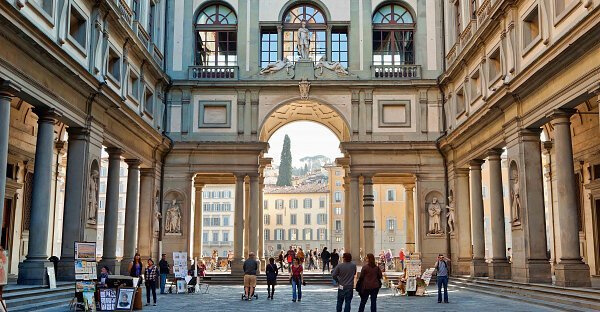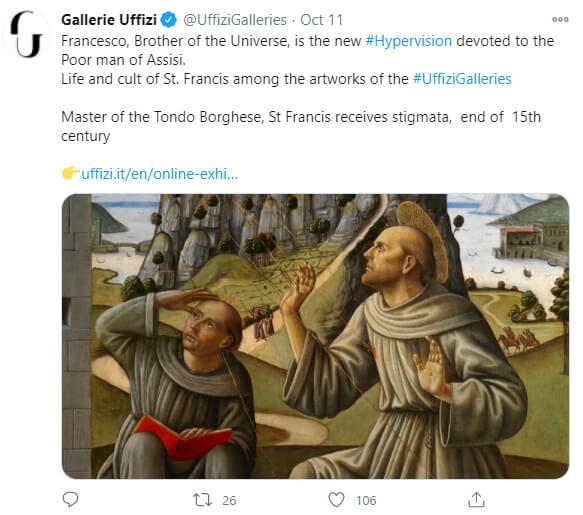Uffizi’s Gallery in Florence is the most important museum in Italy and the 10th most visited museum globally, as it hosts the world’s finest Italian Renaissance art collection, which attracted over four million visitors in 2019.
Amidst its greatest masterpieces, Uffizi exhibits The Birth of Venus (Botticelli, 1484-1486), Doni Tondo (Michelangelo, 1507), Annunciation (Leonardo, 1472-1475) and the biggest collection of Raffaello’s output.
Thanks to these (and many other) incredible artworks, Uffizi has gained a great fame since its foundation in 1769 and Uffizi’s Director, Eike Schmidt, is without any doubt about why the Renaissance charm still works: “It was an age both of cultural and technological progress, with Florence being the hub of this development as a kind of middle ground between New York and the Silicon Valley.
Many goals achieved during that period are still western landmarks, as for visual culture, where, without Paolo Uccello’s output (a 15th century artist who painted eventful war scenes, ed), any Hollywood’s war movie would have been totally different.”
Besides, the legacy of the Renaissance still exerts influence upon many artistic grounds. The US Capitol and the White House are suitable examples of neo-classical art inspired by Italian Renaissance architects like Brunelleschi, Michelangelo or Palladio.
While the Uffizi is a bastion of western artistic tradition, this ancient honour in some sense is also an obstacle to growth. “As we try to change somethings, there are always opposing forces that emerge and we could not carry out experiments without a team heading in the same direction” stresses Mr Schmidt, who has a dual new strategy to improve Uffizi’s appeal worldwide.
On the one hand he wants to promote a slower approach to the museum amidst visitors – “I do not want them to take a selfie and go away” he once stated – but on the other hand he brought the Uffizi on social media, which are the birthplace of selfies and fast contents.
The museum has accounts on Facebook, Instagram, Twitter and TikTok, where according to Mr Schmidt “Uffizi tries to spread even on the net a taste for insight and slowness, mingling visual art with many other contents, like poetry, which is a natural invitation to meditation. Moreover, we do not post only our most famous masterpieces, but even unknown artworks like Francesco Forini’s drawings that became very popular after being posted.”
Uffizi’s media strategy, being so unusual for a centenary museum, has drawn the attention of many around the world, especially as for Uffizi’s TikTok account, where the museum, in order to reach teenagers, has published several irreverent clips.
In one of them there’s a cartoon Coronavirus dancing through the Uffizi. It stops at Caravaggio’s painting Medusa, the mythic creature who turned anyone who dared to gaze at her into stone. The virus turns into rock and it falls down on the floor, smashing in half. Then the painting is shown while wearing a face mask. All this happens with Cardi B’s soundtrack shouting “coronavirus”.
This clip and Uffizi’s TikTok account were the topic of a New York Times article last June, signed by Alex Marshall and titled “As museums join TikTok, Uffizi is class-clown” on the front page of the international edition of the newspaper.
Did Mr Schmidt or anyone at the Uffizi get offended? “No,” tells the Director, “We have not been so serious on TikTok, and so the New York Times did with its title, while the article itself was not offensive at all.”
That was not the first time the Nyt and the Uffizi had a misunderstanding. The Times took part in a critics debacle against the Uffizi’s attribution of the bronze Renaissance sculpture Venus in the Bathroom to the Italian Renaissance artist Giambologna.
On the global critics scenario, the issue gained lots of interest, prompting even one of the most important art revue, the Burlington Magazine, to take a stand in favour of the Uffizi.
“Nowadays Uffizi should take ever more stands like this if it wants to be not only a depository but a scientific research hub. Our image takes advantages from contention like this,” comments Eike Schmidt, who is one of the most expert scholars of Renaissance bronze sculptures.
Among quarrels and critics, directing a museum like the Uffizi is not easy, also because it is not enough being an art historian or a manager. “You must be both, but this is not new for the Uffizi’s Gallery, as when It was opened to the public back in 1769. It was controlled by the Economy Ministry of Tuscany, even if this was a cultural place”.
Nowadays indeed good management skills are also needed to handle the loss of 12 million euros caused by the 2020 spring lockdown, when social media, innovation and renewal had never been so useful to survive.
In order to repair lockdown’s damages, Schmidt’s aim now is to valorize the collection as much as possible, maybe as he saw doing it in the USA, where he worked as a curator for the National Museum of Washington, Los Angeles’ Getty Museum and Minneapolis Institute of Art.
These work experiences nowadays prompts him to say that “Many American colleagues of mine are stricken when they see lots of masterpieces hanging together in one only corridor as it happens here in Florence, because in the USA they would probably set an entire museum out of them.”
And, as a matter of fact, they did it, the whole world did it, as there’s not any mention-worthy classical western museum which does not host any Italian Renaissance masterpiece or any artwork inspired by Renaissance tradition.
So, in the modern age Uffizi is like a giant, rather than a “class-clown.” Nevertheless it struggles to keep its charm alive as many museums do, because, as the time goes on, Renaissance art seems to be always the same old-fashioned piece of history that does not change.
But it isn’t so, Uffizi’s duty today is to give to this art a new shape, because culture survives only thanks to people who give it a sense suitable for the age they’re living. It doesn’t matter when a picture was painted or a sculpture created, because when a guy on TikTok will see it for the very first time it will be almost a rebirth for the artwork, which will become a laugh, a thought or simply a good memory.
That being said, the artwork will continue to exist for another generation, which is why we owe some thanks to the Uffizi’s Gallery for keeping alive our western artistic heritage, which is so contemporary both on TikTok and in reality.
Author
-

Dario Pio Muccilli is the Star-Revue’s Italian correspondent, based in Turin. Email him at muccillidariopio@gmail.com
View all posts
Dario Pio Muccilli is the Star-Revue’s Italian correspondent, based in Turin. Email him at muccillidariopio@gmail.com











